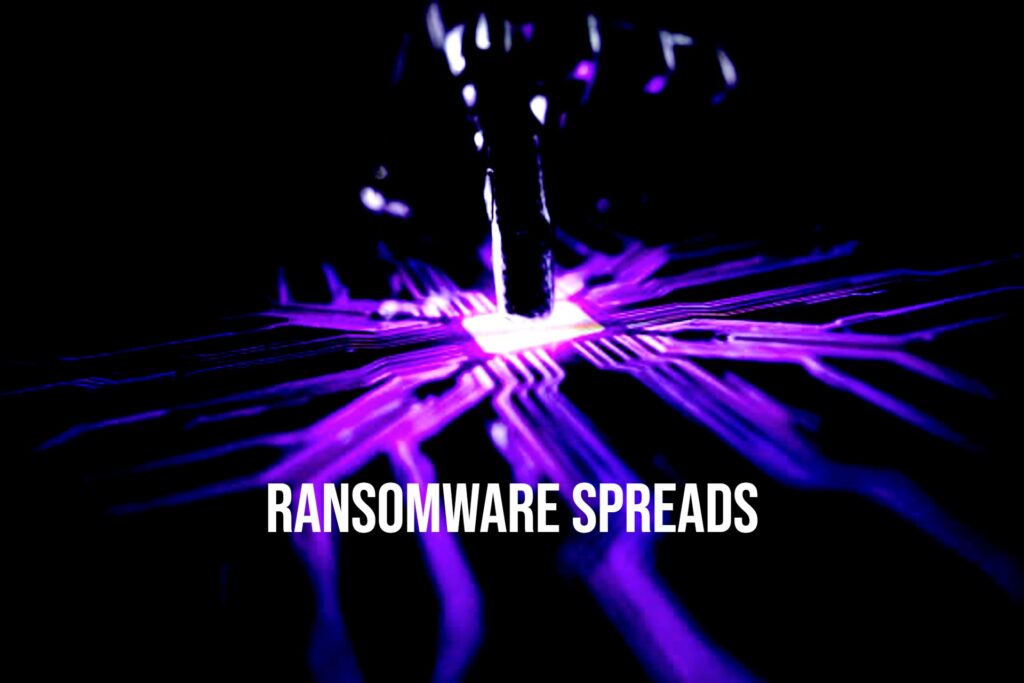Ransomware has become one of the most significant and widespread cyber threats of our time. It is a type of malware that encrypts a victim’s files and demands a ransom payment to restore access. However, this article, examines how ransomware spreads.
The rapid rise of ransomware has become a major concern for individuals, businesses, and governments alike, causing widespread damage and financial losses.
We’ll delve into the methods and techniques that cybercriminals use to spread ransomware, and what you can do to protect yourself from these attacks.
It doesn’t matter your level of knowledge. Whether you’re a seasoned IT professional or just someone starting out on cybersecurity threats, this article is a must-read.
Get ready to learn about the dark side of technology and how ransomware spreads like wildfire.
How does ransomware spread laterally?
A ransomware attack is a malicious attack that encrypts your files, leaving you to pay a ransom for your files release. The aftermath of an initial attack is what enables ransomware to spread throughout your network.
Cybercriminals employ various methods to spread ransomware, such as phishing emails with malicious links or attachments, portable devices, public WiFi, and Zero-Day vulnerabilities.
Knowing how ransomware spreads is key to defending against it. Ransomware is a growing concern for businesses worldwide, threatening financial security and exposing confidential information.
Every business should have intrusion detection and prevention measures in place. Don’t let your business email become compromised through phishing or other cyberattacks, which undermines your credibility.
Protect yourself and your employees, as well as your customers, by researching and implementing the best security tools available.
ransomware through the network
Can ransomware spread through the network? Ransomware can spread throughout a network in several ways. One common method is through phishing emails that contain malicious links or attachments. When a user clicks on the link or opens the attachment, the ransomware infects their device and starts to encrypt files. From there, it can spread to other devices connected to the same network.
Another way ransomware can spread is through portable devices, such as laptops and external hard drives, that are infected with the malware and then connected to another network. This can also occur when a user connects to public WiFi, as the malware can infect the device through unsecured networks.
Additionally, ransomware can spread through Zero-Day vulnerabilities, which are security flaws in software that have not been discovered or addressed. When a hacker exploits these vulnerabilities, they can infect a network with ransomware.
It’s important for businesses and individuals to take precautions to prevent the spread of ransomware, such as regularly updating software, implementing security measures such as firewalls and antivirus software, and being cautious of suspicious emails and links.
How do hackers distribute ransomware?
Hackers distribute ransomware through various means to infect as many devices and networks as possible. Some common methods include:
Using Malware
Malware is a term used to describe any malicious software, including ransomware. This type of software takes the form of a Trojan horse, appearing as a legitimate file, but executing harmful code when opened or downloaded by the user.
If the intention is to extract a ransom, the malware will encrypt data on the victim’s computer, denying the owner access to it. The victim must then pay the ransom to regain access to their data. There are no guarantee though. These cyber criminals could still exfiltrate the information for future use. That is what is socially disturbing about ransomware.
Through Email
Phishing attacks are one of the most prevalent ways of delivering ransomware. Hackers trick individuals into clicking on a link or opening an attachment that downloads ransomware onto their system. These attacks often use social engineering tactics where the cybercriminals pose as someone the recipient trusts and trick them into granting administrative access to the corporate systems.
Dangerous Web Pages
Malicious ransomware code can be found in web scripts hiding on seemingly legitimate or compromised websites. This type of attack is effective because victims believe they are visiting a trusted site.
Upon visiting the site, the code is automatically downloaded to infect their system. Thus spreading laterally across the organization and encrypting data and files.
Misleading Pop-ups
Ads and pop-ups are another common web-based method for ransomware attacks. They appear legitimate but trick people into clicking on them by pretending to be a trusted brand.
Once clicked, they direct the user to a new window with malicious links. These links perform malware or ransomware automatic download to the user’s computer and assume control.
Instant Messaging Risks
As individuals become more aware of email-based phishing schemes, hackers have shifted their focus to instant messaging platforms such as WhatsApp, Slack, Snapchat, Facebook Messenger, and Microsoft Teams. These threats operate similarly to email attacks, where ransomware is launched when a user clicks on a link or attachment from a sender pretending to be a reputable company.
With the rise of remote work, instant messaging has become a critical collaboration tool for businesses, making these attacks harder to avoid.
Text Message Threats
Text messages are a popular means for ransomware attacks, with spam, spoofing, and phishing messages being the main culprits. Attackers often use ransomware-as-a-service or malware-for-hire to execute cost-effective ransomware attacks. When a user clicks on a link, the ransomware is downloaded to their device and can spread to everyone in their contact list, including co-workers.
The Power of Social Engineering
Social engineering is one of the most successful ransomware attack vectors. This tactic can include phishing and smishing or a combination of both, allowing ransomware attackers to gain administrative access to a computer system. From there, they can move swiftly throughout an organization’s digital environment, encrypting high-value data and files.
- Phishing emails – sending emails that contain malicious links or attachments that infect a device when clicked on.
- Drive-by downloads – infecting a device when a user visits a compromised website.
- Exploiting vulnerabilities – exploiting weaknesses in software or systems to infect a network with ransomware.
- Malicious software updates – disguising malware as legitimate software updates to trick users into downloading it.
- Watering hole attacks – compromising a website that is frequently visited by the intended target and infecting their devices when they visit the site.
- Ransomware-as-a-service – allowing cybercriminals to purchase and use ransomware without having technical expertise.
It’s important to note that hackers are constantly developing new methods to distribute ransomware, so it’s crucial to stay informed and take preventative measures to protect against these attacks.
What is the most common method of attack for ransomware?
The most common method of attack for ransomware is phishing emails. These emails contain malicious links or attachments that when clicked on, infect the device with ransomware.
This is an effective method for hackers as people often trust emails from seemingly legitimate sources, leading them to inadvertently download the malware.
To protect against phishing attacks, it’s important to be cautious of emails from unknown senders and to avoid clicking on links or downloading attachments unless you’re certain of their safety.
ransomware spread without Internet
One of the questions that often come up when building a malware robust system is, “Can ransomware spread without Internet?” In cyber security detection and prevention game, nothing is ever black or white. A more laudable answer would be, ‘it depends..’ on the situation of course.
Ransomware can spread without an Internet connection. Although it is more limited in its ability to do so. Ransomware can spread within a local network or to connected devices, such as through shared drives or portable devices, without the need for an Internet connection.
What’s important here is the level of awareness of those involved. For example, some forms of ransomware can be physically be transported on a device. These devices can inadvertently spread these malware to other connected devices when plugged in. Such devices are USB drives, SSD cards etc.
However, without an Internet connection, ransomware is less likely to spread beyond the initial infected network or device, and its ability to receive payment for the ransom is also hindered.
In this scenario, you can see how ransomware spreads can be inhibited by lack of access to the internet. For small scale companies, this online isolation is a reality without much difficulty compared to larger firms.
This is why many ransomware attacks target large networks or enterprise systems, where they can spread quickly and potentially impact many devices.
What are the two main types of ransomware?
The rise of malicious software, is crucial to understand the different types of ransomware and how they work. There are two main types of ransomware – encrypting ransomware and locker ransomware. Understanding these types of ransomware will help you better protect yourself and your organization against potential attacks. Getting to know about the dark side of technology and the different ways ransomware can compromise your data. Here are the two main types of ransomware:
Encrypting Ransomware
This type of ransomware encrypts the files on the infected device, making them inaccessible to the user. The attacker then demands a ransom payment in exchange for the decryption key to restore access to the encrypted files. This type of ransomware is designed to cause significant harm to the victim by rendering their data inaccessible.
Locker Ransomware
This type of ransomware restricts access to the infected device or computer system, effectively “locking” the user out of their own device. The attacker then demands a ransom payment in exchange for the unlocking the device. This type of ransomware is less common than encrypting ransomware but can still cause significant disruption.
However, both types of ransomware can be incredibly disruptive and costly. It is important to take steps to protect yourself against these types of attacks by implementing proper security measures. This may mean maintaining regular backups of important data. Remember, it is cheaper to prevent ransomware spreads than doing the clean up.
How fast does ransomware spread?
Ransomware is a malicious software that has the capability to spread at an alarming speed, causing widespread destruction in its wake. The speed at which ransomware spreads is dependent on several factors, including the sophistication of the attacker, the number of vulnerabilities in the system, and the type of attack vector used.
One of the most common attack vectors is phishing, where cybercriminals trick individuals into opening an attachment or clicking on a link that downloads the ransomware onto their system.
Once the ransomware infects a device, it can quickly spread to other connected devices, both locally and through the cloud. This makes it crucial for organizations to implement robust security measures to prevent the spread of ransomware.
Another factor that contributes to the speed of ransomware spread is the use of remote access tools such as VPNs. With an increasing number of employees working from home, hackers have taken advantage of VPNs to launch ransomware attacks.
The remote access provided by VPNs can be a double-edged sword as it offers a convenient way for employees to access corporate systems, but it also provides a backdoor for hackers to launch ransomware attacks.
To prevent the rapid spread of ransomware, organizations need to take a multi-layered approach to security. This includes regularly patching vulnerabilities, implementing strong authentication measures, and educating employees about the dangers of phishing attacks.
In addition, organizations should invest in backup and disaster recovery solutions that can quickly restore systems in the event of a ransomware attack. By being proactive, organizations can help mitigate the risk of ransomware and prevent its spread.
ransomware spread over VPN
Can ransomware spread over VPN? Anything is possible. Ransomware spreads over VPN can be a serious concern for businesses and organizations that rely on virtual private networks (VPNs) for remote work.
VPNs are commonly used to provide secure access to an organization’s internal network, but they can also be a weak point in an organization’s cybersecurity defenses.
When a VPN is hacked, ransomware can spread quickly across the organization’s internal network, encrypting valuable data and systems, and disrupting critical business operations.
One of the main ways that ransomware spreads over VPN is through phishing attacks. Hackers can use phishing emails or social engineering techniques to trick employees into downloading malware or giving away their login credentials.
Once the attacker has gained access to the VPN, they can then spread the ransomware throughout the network.
Another way that ransomware spreads over VPN is through unpatched vulnerabilities in the VPN software. If an organization does not keep its VPN software up to date with the latest security patches, then it is at risk of a ransomware attack. Hackers can exploit known vulnerabilities in the software to gain access to the VPN and spread the malware.
To prevent ransomware spreads over VPN, organizations need to implement robust cybersecurity measures, including anti-virus and anti-malware software, firewalls, intrusion detection and prevention systems, and regular security audits.
They also need to educate their employees about the dangers of phishing attacks and the importance of good cybersecurity practices. By taking proactive measures to protect their VPNs and their internal networks, organizations can reduce the risk of a devastating ransomware attack.
ransomware spread in cloud Environment
Can ransomware spread to cloud? Ransomware is a malicious software that encrypts a victim’s data and demands payment in exchange for access to it. In a cloud environment, the risk of ransomware spreading is even higher, as a single infected device can potentially infect the entire network.
The cloud’s dynamic nature, combined with a lack of security measures, makes it a prime target for ransomware attackers.
One of the most common methods of spreading ransomware in the cloud is through phishing emails. Hackers can send emails that appear to be from a trusted source and contain links or attachments that, when clicked, download the ransomware.
Social engineering tactics can also be used to trick individuals into granting administrative access, enabling the attacker to spread the ransomware throughout the network.
Web-based attacks, such as those from malicious websites or pop-ups, can also spread ransomware in the cloud. Instant messaging platforms and text messages have become popular attack vectors as well, with hackers using smishing campaigns to spread the malware.
To prevent ransomware from spreading in a cloud environment, it is important to have strict security measures in place. This includes regularly updating software and systems, educating employees about potential threats, and backing up data regularly to ensure that important information can be recovered in the event of an attack.
Cloud environment and ransomware spreads can be catastrophic. This can lead to financial losses and disruption of business operations. Therefore, adopting strong security measures and being vigilant against potential threats is essential in protecting against these attacks.
Ransomware targets and Why
The growing threats of ransomware seem to have found its target in critical services. The question is, “Who are the top 5 targets of ransomware?” The top targets of ransomware attacks are hospitals, schools, government agencies, and large corporations.
These targets are often selected because they rely heavily on their computer systems and cannot afford the disruption of a ransomware attack. Attackers know that these types of organizations are willing to pay a ransom to restore their systems quickly.
As the use of technology continues to increase, so does the risk of ransomware attacks, making it crucial for all organizations to take proactive measures to protect themselves against this type of threat.
Ransomware is a growing threat in the digital world, with numerous organizations and individuals falling victim to this malicious software. The top five targets of ransomware attacks are organizations in various industries, including healthcare, finance, government, education, and technology. These industries hold sensitive and valuable information, making them prime targets for cybercriminals seeking to profit from a ransom.
Healthcare organizations, in particular, are vulnerable to ransomware attacks due to the critical nature of their work and the sensitive information they store, such as patient records and medical history. This data is often highly sought after by attackers, who can leverage it for ransom or sell it on the dark web.
The finance industry is also a common target for ransomware, with banks, credit unions, and investment firms holding vast amounts of sensitive financial data. Government organizations, including city and state agencies, are also at risk due to their vast databases and large networks, making them attractive targets for attackers.
Similarly, educational institutions, like universities and schools, hold sensitive student data. These include personal information and grades which makes them appealing targets for ransomware attackers.
The technology industry, and its servicing companies, are also susceptible to ransomware attacks because of the valuable information and intellectual property they hold.
In conclusion, it’s crucial for organizations in these industries to prioritize cybersecurity and implement effective measures to protect against ransomware attacks, as they are the top targets for cyber criminals. By doing so, they can mitigate the risk of losing sensitive information, reduce the potential impact of a ransomware attack, and maintain their reputation and trust with customers.
What is the most common cause of ransomware?
Ransomware is a type of malicious software that has become a major concern for individuals and organizations alike. The most common cause of ransomware attacks is the downloading of infected attachments or clicking on malicious links in emails, instant messages, or websites.
This opens a pathway for the ransomware to infect the computer and spread throughout the network. Ransomware is designed to encrypt the victim’s files, making them inaccessible until a ransom is paid to the attacker.
The speed at which ransomware spreads depends on various factors, including the security measures in place, the type of ransomware, and the way it was delivered to the system.
Despite advancements in cybersecurity, the threat of ransomware continues to grow. It is essential to take proactive measures to prevent the spread of ransomware. For example, implementing a backup strategy, keeping software and security systems up to date, and avoiding suspicious emails or links.
Additionally, organizations should conduct regular security assessments to identify vulnerabilities and take action to mitigate the risk of a ransomware attack.
The consequences of a ransomware attack can be severe, ranging from loss of sensitive data to financial losses due to downtime and ransom payments.
To protect against these risks, it is important to understand the most common cause of ransomware attacks and take appropriate measures to prevent them.
By implementing best practices and staying vigilant, individuals and organizations can reduce the risk of a ransomware attack and prevent the spread of this malicious software.
How ransomware attacks are executed
Ransomware attacks are increasingly common threat for businesses and individuals alike. This malicious software encrypt important files and hold them hostage until a ransom is paid, causing significant disruption and financial loss.
The most common method of execution for these attacks is through phishing scams. The attackers send emails that appear to come from a trusted source, encouraging the recipient to click on a link or download an attachment that contains ransomware.
Once the ransomware has been installed on a device, it quickly spreads to other connected systems. For example, the networks, cloud storage, and other connected devices.
This is why it’s essential to take preventative measures to protect against ransomware, such as backing up important data regularly, using anti-virus software, and being cautious when opening emails from unknown sources.
Additionally, some attackers will target specific businesses or organizations, using sophisticated tactics to penetrate their defenses and spread the ransomware.
In these cases, it’s essential for companies to implement robust security protocols, including firewalls, encryption, and employee training programs to educate employees on how to identify and prevent potential attacks.
Overall, understanding the methods by which ransomware attacks are executed is crucial in taking the necessary steps to protect yourself and your organization. By being vigilant and proactive, you can reduce the likelihood of falling victim to a ransomware attack and minimize its impact should one occur. Ransomware attacks are executed in several stages. These are:
Initial infection
The ransomware is delivered to the target device through methods such as phishing emails with malicious attachments. They may also use drive-by downloads from compromised websites, and exploiting vulnerabilities in software or operating systems.
Encryption and Ransomware spreads
Once the ransomware infects the device, it begins to encrypt files and make them inaccessible to the user. The encrypted files may include important documents, images, and other sensitive data.
Demands for ransom
The attacker then demands payment, usually in the form of cryptocurrency, in exchange for the decryption key needed to regain access to the encrypted files. The ransom amount may increase if the victim fails to pay within a specified time frame.
Propagation of Ransomware spreads
In some cases, the ransomware can spread to other connected devices or networks. For example, through shared drives or file servers, and infect multiple systems.
The end goal of the ransomware attack is to force the victim to pay the ransom. You can limit this risk. Use ransomware cloud backup to minimize and regain access to your data before their encrypted files. It is important to note that paying the ransom does not guarantee that the files will be decrypted and restored. Therefore, it is crucial to implement proper security measures which maintains regular backups. Prioritize your important data to minimize the impact of a ransomware attack.
Your Takeaway
Ransomware has become a widespread and damaging cyber threat to individuals, businesses, and governments alike. Having an understanding of how ransomware spreads through various methods and techniques is important. Cyber criminals employ an array ways to con people to surrender their credentials. But if we can equip ourselves with the right knowledge and awareness, we can better protect ourselves against these attacks. Whether you’re a seasoned IT professional or just starting out. Ensure to learn about cybersecurity. Staying informed and taking proactive steps is all about preventing ransomware which is essential in today’s digital landscape.




